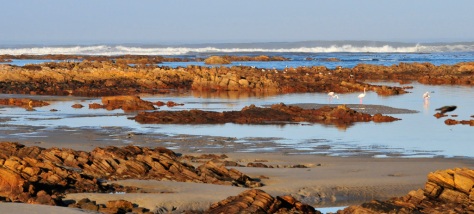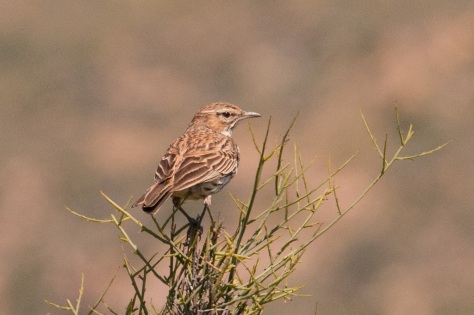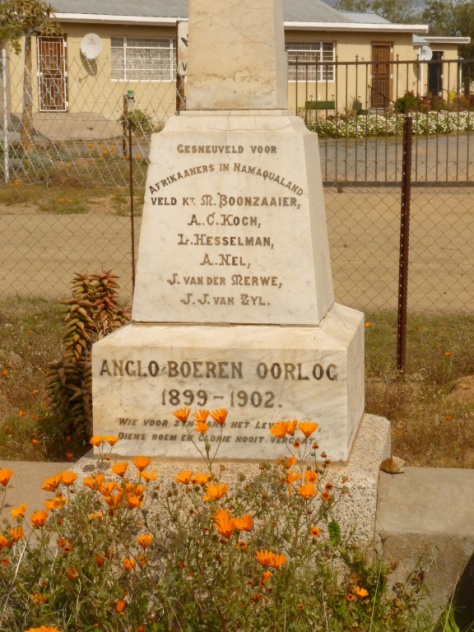The Trip (continued)
This is the follow-on to Part 1, which covered the first 5 days of the road trip. In this Part we continue the next 5 days of our Birding and Flowers trip, taking in the prime flower-spotting areas of Namaqualand and adding to the growing “trip list” of birds seen along the way.
Day 6 (24th August 2013) :
Still in Port Nolloth, we woke up to a beautiful scene, with the lagoon in front of the beach house as smooth as a mirror, reflecting the small groups of Greater Flamingos (Grootflamink) as they showed themselves off to great effect. Mingling with the flamingos were Little Egret (Kleinwitreier), Kelp and Hartlaub’s Gulls (Kelp- en Hartlaubse meeu), Cape and Bank Cormorants (Trek- en Bank-kormorant) and a charming family of South African Shelduck (Kopereend) – Mom & Dad + 2 youngsters following eagerly.


On the sand in front of the house, Common Starlings (Europese spreeu) and Cape Wagtails (Gewone kwikkie) were busy feeding while Swift Terns (Geelbeksterretjie) flew overhead in small flocks and an African Black Oystercatcher (Swarttobie) worked the shoreline for a tasty morsel or two. Not far from them a lone White-fronted Plover (Vaalstrandkiewiet) trotted about after unseen prey and offshore at a distance I was able to pick up a Cape Gannet (Witmalgas) with the help of my newly acquired spotting scope.

Walking along the beach and across the flat rocks, we found ourselves on another beach with a larger lagoon/bay, which held a single Pied Avocet (Bontelsie) and the largest flock of Black-necked Grebes (Swartnekdobbertjie) we have ever seen – probably 60 or more.

Koos and I then set off on a drive to complete the minimum 2 hour atlasing period and to see if we could find the sought-after Barlow’s Lark (Barlowse lewerik) which is a Port Nolloth “special” and said to be found not far from town on the road to Alexander Bay. Well, we followed the lead given by Birdfinder and tried hard for a sighting, but eventually decided we would have a better chance in the early morning, when they were more likely to show themselves and perhaps call. We had some compensation by way of Cape Long-billed Lark (Weskuslangbeklewerik), another lifer for me, which we found in the scrub-covered dunes after hearing its typical descending whistle, a sound we were to hear a number of times in the following days.

We discovered a small wetland closer to town, signposted Port Nolloth Bird Sanctuary, that held a variety of bird life, dominated by Lesser and Greater Flamingos – possibly the same ones seen earlier feeding in the lagoon – but also holding Cape Teal (Teeleend), Avocets, Cape Shoveler (Kaapse slopeend) and large numbers of Hartlaub’s Gulls. From there we followed the map to the large, mostly bone-dry, pan further north which was home to more Hartlaub’s Gulls (100+) but not much else.



Having done our Citizen Scientist (no, it’s not a sect) duties for the day we spent the rest of the day relaxing and enjoying the beach view, ever-changing with the tides and winds. Later we tried the local Italian restaurant “Vespettis” which served up a decent meal after which Koos called up the daily bird list to add to our growing trip list.
Day 7 (25th August 2013) :
We were due to vacate the beach house by 10am, but first we had an important mission to accomplish – find the Barlow’s Lark. A chilly dawn saw Koos and I in the same area as the day before, stopping frequently and searching for any signs of the Lark amongst the low scrub clinging to the dunes. A rather intimidating sign on the fence reminded us that we were skirting a restricted mining area! We drove slowly for a few Kms northwards but kept coming up with Tractrac Chats and Cape Long-billed Larks whenever movement was spotted – not that these were birds to dismiss, as they were both lifers for me in the preceding days, but we were hoping desperately for a Barlow’s Lark, which was our main reason for choosing Port Nolloth as a stopover in the first place. After an hour or more of searching we decided to turn around and as we did so we heard a different-sounding call and leapt out of the car to find the source – yes, you guessed it, there was a Barlow’s Lark on the telephone wire and he obliged by flying up above our heads and commencing a display flight, which involves a lot of hovering in the air while calling continuously, then descending rapidly to a low bush for a minute or so before repeating the sequence several times, while we watched enthralled. It reminded me of the Melodious Lark’s display that I had seen earlier in the year but without the variety of mimicked calls. Apart from the thrill of adding another lifer, the whole display was a bit of birding magic and we both agreed this was one of those special moments to be treasured.




A little later we left Port Nolloth and headed back to Springbok with a good feeling about our short visit to this small coastal town. Before reaching Springbok we branched off to the town with the unusual name – Nababeep (“Rhinoceros place” in the old Khoi language) and stopped to view the spectacular displays of yellow and orange daisies which carpet the roadside and extend up the hillsides.




From there it was a short drive to Kamieskroon where we found the road to Namaqua National Park for our next night’s stop. Rock and Greater Kestrels (Kransvalk & Grootrooivalk) and Pale Chanting Goshawks (Bleeksingvalk) are regular occupants of the roadside poles in these parts, in addition to the ubiquitous Crows. Approaching the park we could see the flowers blanketing the landscape from a long way off and as we got closer the beauty of the flower display was almost overwhelming. We tore ourselves away from the scene to check in and let the ladies explore the “Padstal” after which we made our way slowly to the chalet in the “Skilpad” section of the park, admiring the variety of flowers and birding along the way, with Sunbirds and Larks being most prominent.



On arrival at the chalet a Grey Tit (Piet-tjou-tjou-grysmees) immediately made his presence known with his loud and distinctive call – another lifer added! A short walk produced a busy pair of Layard’s Titbabblers (Grystjeriktik), several Malachite Sunbirds (Jangroentjie) and Karoo Scrub-Robin (Slangverklikker). In no time it was dusk and time to braai, re-live the special day and get some rest.




Day 8 (26th August 2013) :
Early morning mist had cleared by the time we left and we enjoyed the circular route through the flowering landscape back to the office to hand in our keys before venturing further. At the office I spotted a Ludwig’s Bustard (Ludwigse pou) doing a fly past allowing me the pleasure of clocking up lifer No 700 for Southern Africa, which earned a few “high-fives”.






Having made the most of our short stay we had decided to head further into Namaqua park, along the road to Soebatsfontein (Afrikaans for “pleading fountain”), marked as 4 X 4 only but by no means a rough road and well worth doing, as we were to find out. The road to Soebatsfontein winds its way through the mountain ridges, and the wonderful scenery makes it one of the best roads I have driven. Along the way Cape Clapper Larks (Kaapse klappertjie) did their distinctive display flight as did the Karoo Larks. Cape Buntings (Rooivlerkstreepkoppie) were plentiful with a few Black-headed Canaries (Swartkopkanarie) adding to the mix. While we were enjoying roadside coffee and the delicious melktert (custard tart) from the park’s shop we were entertained by yet another displaying Lark, this time Red-capped Lark (Rooikoplewerik), flying up from a termite mound while calling, then plummeting rapidly before repeating a few minutes later.



Our lunchtime stop was about halfway along the road near the ruins of an old farmstead, which was probably built with mud bricks which by now had partly dissolved giving it a “Timbuktu-like” appearance. During the drive we had seen a good selection of raptors including Jackal Buzzard (Rooiborsjakkalsvoel), Verraux’s Eagle (Witkruisarend), Booted Eagle (Dwergarend) and a Black-chested Snake-Eagle (Swartborsslangarend).



Once we reached the small village of Soebatsfontein we took the dirt road to Kamieskroon, then via the N7 to the turn-off to No-Heep farm where we had booked accommodation for the next 2 nights. On arrival the owners showed us to the charming old farmhouse nearby, with solar-powered lights and gas for cooking, fridge and hot water. There was time for a short walk to explore the surroundings before dusk descended – in the fading light a Verraux’s Eagle and a Booted Eagle were still vying for prime patrolling spot along the nearby mountain ridge.






Day 9 (27th August 2013) :
After a relaxed breakfast I set off for a lengthy late-morning walk up towards the mountain where the Eagles had been patrolling the previous evening. The morning shift now comprised a handsome Jackal Buzzard and a Rock Kestrel doing patrol duty along the same stretch of mountain ridge, the former coming in quite low to show off his rich rufous and black and white colouring as he cruised past. At ground level, Karoo Larks were displaying energetically, while Cape Buntings and Grey Tits carried on with their daily routines. Common Quail (Afrikaanse kwartel) stuck to the rule “be heard and not seen” as they crept unseen through the grass, given away only by their pip- pip- pip call. Up on the lower slopes of the rocky hillside, a Grey Tit played hide and seek with me – responding to my playing his call but remaining wary and partly hidden in the branches of a tree, making photography difficult.





A small lizard with a very long tail attracted my attention and I waited patiently for it to come out into the open – my reference book later confirmed it to be a Sand Lizard. A Karoo Prinia (Karoolangstertjie) on top of a handsome Quiver tree, a feature of the area, made a memorable picture in my mind but he didn’t hang around long enough to turn it into a digital image. Further on, a Rufous-eared Warbler (Rooioorlangstertjie) popped up on a bush nearby and eyed me carefully, then disappeared into the bushes. Our only other activity for the day was a late afternoon drive along the farm roads leading north of No-Heep, with more spectacular scenery to enjoy along the winding road through beautiful mountain landscape.






Day 10 (28th August 2013) :
Another travelling day – this time we were headed to a guest farm near Niewoudtville (the locals pronounce it Nee-oat-ville) which is famous for its variety of bulb flowers at this time of year. The route took us back to Kamieskroon where we stopped to find the War monument – as it turned out it was in the church grounds. From there we continued south on the N7 to VanRhynsdorp where we turned east and drove through the flat, almost barren plains known as the “Knersvlakte” (literally the “Grinding flatlands”), so named by the pioneers of this part of South Africa because of the sound of the wagon wheels grinding on the stony, gritty surface.



The plains ended in an intimidating mountain escarpment with a diagonal gash up the side which, as we got closer, turned into a steeply angled road with dramatic views back over the Knersvlakte. As we reached the top we found ourselves in quite different countryside at a substantially higher altitude and soon passed through Niewoudtville, with a quick stop to admire the roadside flowers, on our way to De Lande farm some 13 Km further along a dirt road. At this stage the road was still dry and comfortable to drive on, but this was to change over the next couple of days.


Once settled at De Lande in the “Sinkhuisie” or “Tin House”, we took a walk to stretch the legs and do some initial birding in this new locality. Immediately the presence of Mountain Wheatears was noticeable as they hopped about around and under the car, almost seeming to want to say “hello”. A Black Harrier (Witkruisvleivalk) glided past in his customary low flight over the scrub and disappeared into the distance. Down at the farm dam dusk was approaching and a row of tall blue gums was being populated by growing numbers of Black-headed Herons (Swartkopreier), Sacred Ibises (Skoorsteenveer) and Cape Crows (Swartkraai) as they came in to roost – the trees were altogether quite crowded. The weather had turned and it was by now completely overcast and decidedly cold but this was more than compensated for by the heaters in the house and the warm welcome and superb dinner we enjoyed that evening, served in the main house a stone’s throw away.



The next couple of days were to be a test of the vehicles and our tenacity, but more of that in Part 3 …..

